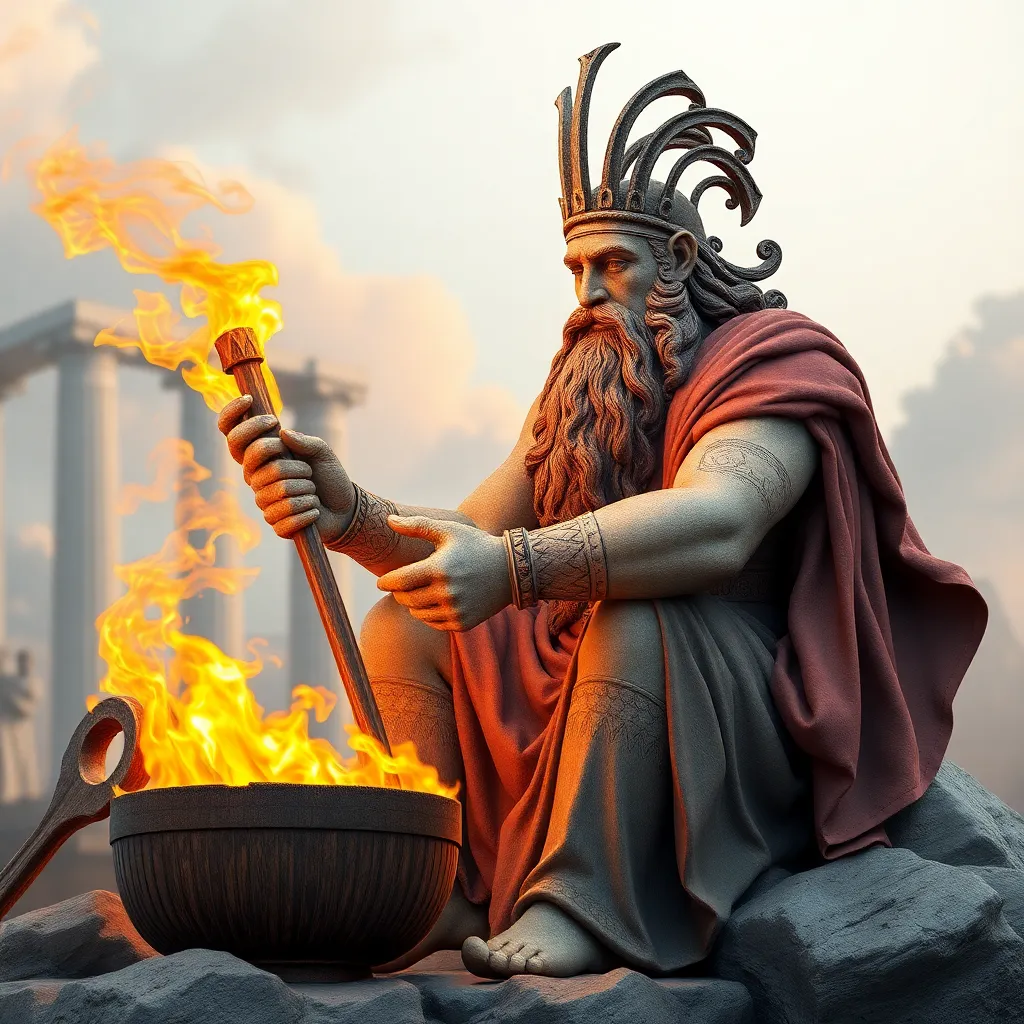Hephaestus and the Nature of Craft in Greek Society
I. Introduction
Hephaestus is a prominent figure in Greek mythology, revered as the god of fire, metalworking, and craftsmanship. His story intertwines with themes of creativity, labor, and the value of skill in ancient society. In a culture that celebrated the art of crafting as essential for both survival and prestige, Hephaestus embodies the pinnacle of artisanal talent and ingenuity.
The importance of craftsmanship in ancient Greek society cannot be overstated. As a critical component of the economy and culture, craftsmanship provided not only goods and services but also a means of social mobility and personal identity. This article aims to explore the role of Hephaestus as a symbol of craftsmanship, examining his myths, influence, and the broader impact of craft in ancient Greece.
II. Hephaestus: The God of Fire and Metalworking
Hephaestus is often depicted as a master craftsman, creating magnificent works from metal and fire. Numerous myths highlight his skills, including his creation of the gods’ weapons and armor, the intricate automata, and even the famous shield of Achilles.
His attributes and symbols are well-known:
- The Hammer: Symbolizing his role as a blacksmith.
- The Anvil: Representing his craftsmanship and labor.
- Fire: Signifying both creation and destruction, as well as the transformative power of his work.
Unlike other Olympian deities, who often embody ideals of beauty and power, Hephaestus represents the practical and functional aspects of life. His physical imperfections, such as being lame, contrast sharply with the often-perfect forms of his fellow gods, highlighting a different kind of strength—one rooted in skill, hard work, and perseverance.
III. The Significance of Craftsmanship in Ancient Greece
Craftsmanship in ancient Greek culture encompassed a wide range of activities, from pottery and sculpture to metalworking and architecture. This multifaceted definition reflects the integral role that skilled labor played in daily life.
Artisans and craftsmen held a vital place in society:
- They provided essential goods, such as tools, clothing, and art.
- They contributed to the economy through trade and commerce.
- They often engaged in community projects, enhancing civic pride and identity.
Craft as a form of social and economic power allowed skilled individuals to gain status and respect. In many cases, a successful craftsman could ascend the social ladder, earning recognition and wealth through their expertise.
IV. Hephaestus’ Influence on Artisanship
As the patron of craftsmen and artisans, Hephaestus inspired countless generations of workers. His mythological creations serve as a testament to the heights that craftsmanship can achieve.
Some notable examples of Hephaestus’ creations include:
- The golden automatons that served the gods.
- The magnificent palace of the gods on Mount Olympus.
- The armor of Achilles, which exemplified both beauty and functionality.
These stories not only celebrate the art of crafting but also elevate the status of artisans in Greek society. Through the lens of mythology, Hephaestus’ work becomes a symbol of human creativity and the potential for excellence in craftsmanship.
V. Craft as a Reflection of Societal Values
The relationship between skill, labor, and status is a complex one in ancient Greece. Craftsmanship was often associated with honor and recognition, with skilled artisans being celebrated in their communities.
Craftsmanship provided a means for individuals to achieve personal and social success:
- Master craftsmen were often revered and their work sought after.
- Competitions in craftsmanship could lead to fame and patronage.
Gender roles also played a significant part in the division of labor, as certain crafts were deemed appropriate for men or women. While men dominated fields like metalworking and sculpture, women often engaged in textile production and pottery, highlighting a societal structure that both valued and restricted craft based on gender.
VI. The Interplay of Myth and Reality in Craft
The myths surrounding Hephaestus significantly shaped real-life craftsmanship in ancient Greece. As a revered figure, Hephaestus provided ideals for artisans to aspire to, influencing their work ethic and creativity.
His legacy is evident in various artistic expressions of the time, including pottery, sculpture, and architecture, where the principles of craftsmanship were celebrated and elevated. Today, modern interpretations of Hephaestus often reflect a renewed appreciation for craftsmanship, emphasizing its importance in contemporary culture.
VII. Case Studies: Notable Craftsmen in Greek History
Throughout history, several craftsmen have been influenced by the ideals represented by Hephaestus. Notable figures include:
- Phidias: The sculptor responsible for the Parthenon sculptures, embodying the pinnacle of artistic skill.
- Pheidias: Known for his divine sculptures, including the statue of Zeus at Olympia.
- Polykleitos: Renowned for his work in bronze and his treatise on proportion and symmetry.
These craftsmen not only contributed to Greek culture but also serve as living embodiments of Hephaestus’ legacy, blending myth with the tangible reality of their creations.
VIII. Conclusion
In summary, Hephaestus plays a crucial role in shaping the nature of craft in Greek society. His myths and attributes symbolize the value of craftsmanship, encouraging respect for skilled labor and artistry. The lasting legacy of craftsmanship continues to resonate in contemporary culture, highlighting the importance of honoring the roots of creativity and skill.
Ultimately, the stories of Hephaestus remind us of the significance of craftsmanship, not just as a means of production but as a vital aspect of human expression and identity.




